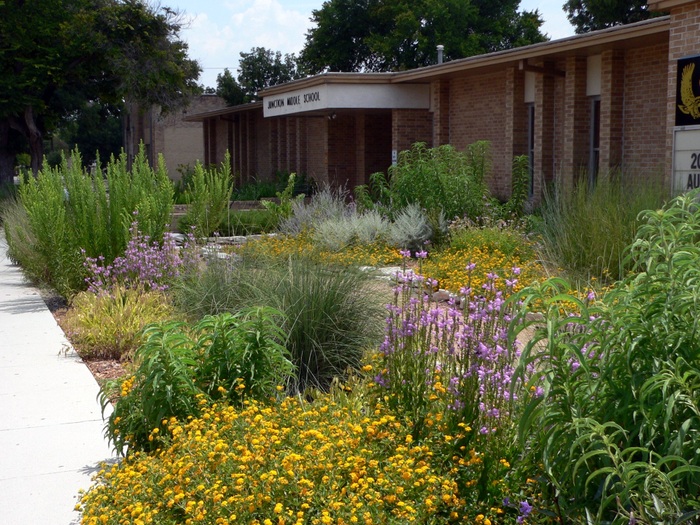Grants to Ohio and New York shoreline communities recently announced by the U.S. Environmental Protection Agency (EPA) are significant steps toward restoring Lake Erie water quality. The Commission commends EPA and the communities for undertaking these projects. It is exciting to see them making green infrastructure work for cities on Lake Erie.
The green infrastructure grants, designed to help cities reduce polluted stormwater runoff, show that the agency is advancing innovative, cost-effective solutions to the lake’s pollution problems.
Green infrastructure projects use vegetation, soil, and natural processes to hold and filter stormwater and melting snow to prevent flooding and contamination, including phosphorus, from reaching surface water and groundwater. They are generally less expensive than conventionally engineered stormwater ponds, retention basins and tunnels.
 An example of a rain garden. Credit: EPA.
An example of a rain garden. Credit: EPA.
In our report on Lake Erie in February, IJC recommended that governments in Canada and the U.S. increase the use of green infrastructure. “Governments should work with municipalitie to promote and accelerate the use of green infrastructure (such as filter strips, rain gardens, bio-swales, and engineered wetlands) in urban stormwater management in the Lake Erie Basin,” the Commission urged.
In Canada, a new Provincial Policy Statement under Ontario’s Planning Act is scheduled to come into effect on April 30. The Policy directs planning authorities to promote green infrastructure to complement infrastructure. It specifically states that planning for stormwater management should “maximize the extent and function of vegetative and pervious surfaces; and promote stormwater management best practices, including stormwater attenuation and re-use, and low impact development.”
EPA announced five grants to Lake Erie shoreline cities:
Lakewood will use a $107,500 grant to install bioretention planters in Madison Park. The project will reduce polluted stormwater runoff by an estimated 403,769 gallons annually and also reduce overflows from the city’s combined sewer system to Lake Erie.
Lorain will use a $250,000 grant to improve stormwater management at the city’s Lakeview Park. The improvements will reduce the amount of bacteria in stormwater being directly discharged to Lake Erie and the frequency of bacteria-related beach closures. The new system, which will be located at the west end of Lakeview Beach, consists of a wetland sand filter approximately 30 feet wide and 120 feet long, that will work in conjunction with a disinfection-based pretreatment device. The new system will reduce bacteria (E. coli) in stormwater being directly discharged to Lake Erie at Lakeview Beach with the goal of reducing the frequency of bacteria-related beach closures.
Toledo will use a $500,000 grant to install bioswales (landscape elements designed to remove silt and pollution from surface runoff water) and rain gardens along the city’s Silver Creek watershed and retrofit the city’s Cullen Park with sand filters and vernal ponds. This project will prevent an estimated 645,000 gallons of untreated sediment and stormwater from discharging to Lake Erie.
Cleveland will use a $500,000 grant to install green infrastructure to absorb rainfall that will reduce the discharge of untreated stormwater near the city’s West Side Market to Lake Erie, reconstructing the West Side Market parking lot with permeable pavers.
Buffalo and the Buffalo Sewer Authority will use a $500,000 EPA grant, along with $500,000 in funding from Empire State Development, to construct green infrastructure projects along a 1-mile section of Niagara Street. The projects include the installation of porous asphalt, stormwater planters, rain gardens and the reduction of impervious pavements. This section of roadway currently generates untreated stormwater that drains directly to the Black Rock Navigation Channel and the Niagara River. The green infrastructure projects will result in the control of up to 4.9 million gallons of stormwater runoff per year and a significant reduction in the amount of road salt, nutrients, oil and grease and sediment flowing into the Niagara River.
These locations are among the 16 cities to receive funding in the initial round of EPA’s new Great Lakes Restoration Initiative (GLRI) Shoreline Cities grant program.

Chair of the US Section of the IJC, headquartered in Washington, D.C.



